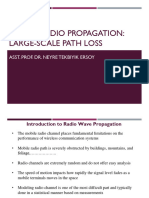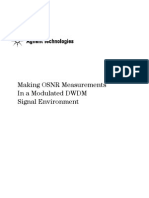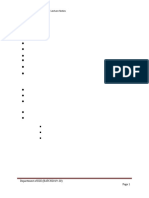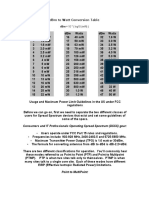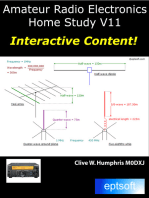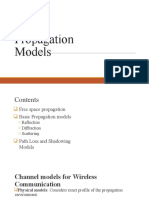Laird Wireless Understanding Range RF Devices
Laird Wireless Understanding Range RF Devices
Uploaded by
bromsatCopyright:
Available Formats
Laird Wireless Understanding Range RF Devices
Laird Wireless Understanding Range RF Devices
Uploaded by
bromsatOriginal Description:
Original Title
Copyright
Available Formats
Share this document
Did you find this document useful?
Is this content inappropriate?
Copyright:
Available Formats
Laird Wireless Understanding Range RF Devices
Laird Wireless Understanding Range RF Devices
Uploaded by
bromsatCopyright:
Available Formats
Understanding Range for
RF Devices
October 2012
Understanding how environmental factors can
White Paper affect range is one of the key aspects to deploying a
radio frequency (RF) solution. This paper will provide
a high-level overview of the factors that can affect
RF range, including hardware selection,
environmental factors, frequency ranges, and
proper implementation.
Americas : +1-800-492-2320 Option 3
Europe : +44-1628-858-940
Hong Kong : +852-2268-6567 x026
www.lairdtech.com/wireless
White Paper
Understanding Range for RF Devices
CONTENTS
Understanding Range for RF Devices ......................................................................................................... 2
Link Budget and Path Loss........................................................................................................... 2
RF Range as a Function of Frequency ......................................................................................................... 4
Antenna and Cable Selection ...................................................................................................... 4
Antenna Height ........................................................................................................................... 6
Conclusion .................................................................................................................................................... 6
© Copyright 2012 Laird Technologies. All Rights Reserved. 1
White Paper
Understanding Range for RF Devices
UNDERSTANDING RANGE FOR RF DEVICES
Understanding how environmental factors can affect range is one of the key aspects to deploying a radio
frequency (RF) solution. Whether you are looking to connect across 10 meters in a crowded hall or 10
kilometers outdoors, the environment plays a significant role in the maximum range that can be achieved.
This white paper explains how range numbers are calculated and discusses the factors that limit range.
Link Budget and Path Loss
For simplicity, RF characteristics are often measured in decibel-milliwatt, or dBm. A decibel is a logarithmic
unit which is a ratio of the power of the system to some reference. A decibel value of 0 is equivalent to a
ratio of 1. For every increase of 10 dB, the actual power increases by a factor of 10. Decibel-milliwatt is the
output power in decibels referenced to one milliwatt (mW). Since dBm is based on a logarithmic scale, it is an
absolute power measurement. For every increase of 3 dBm there is roughly twice the output power, and
every increase of 10 dBm represents a tenfold increase in power. 10 dBm (10 mW) is 10 times more powerful
than 0 dBm (1 mW) and 20 dBm (100 mW) is 10 times more powerful than 10 dBm . The power conversion
between mW and dBm are given by the following formulas:
P(dBm) = 10 · log10( P(mW) ) and P(mW) = 10(P (dBm)
/ 10)
Table 1: mW to dBm Conversion (approximate)
(http://www.rapidtables.com/convert/power/mW_to_dBm.htm)
Power (mW) Power (dBm)
0+ mW -∞ dBm
0.01 mW -20.0 dBm
0.1 mW -10.0 dBm
1 mW 0.0 dBm
2 mW 3.0 dBm
3 mW 4.8 dBm
4 mW 6.0 dBm
5 mW 7.0 dBm
6 mW 7.8 dBm
7 mW 8.5 dBm
8 mW 9.0 dBm
9 mW 9.5 dBm
10 mW 10.0 dBm
100 mW 20.0 dBm
1 W (1000 mW) 30.0 dBm
10 W 40.0 dBm
10 MW (10000 KW) 100.0 dBm
© Copyright 2012 Laird Technologies. All Rights Reserved. 2
White Paper
Understanding Range for RF Devices
Path loss is the term for the reduction in power density that occurs as a radio wave propagates over a
distance. The primary factor in path loss is the decrease in signal strength over distance of the radio waves
themselves. Radio waves follow an inverse square law for power density: the power density is proportional to
the inverse square of the distance. Every time you double the distance, you receive only one-fourth the
power. In decibels per milliwatt, this means that every 6 dBm increase in output power results in a doubling
of the possible distance that is achievable.
Power (dBm)
Range (km)
Figure 1: Range (km) vs. Output Power (dBm)
When both output power and receiver sensitivity are stated in dBm, you can use simple addition and
subtraction to calculate the maximum path loss that a system can incur:
Maximum Path Loss = Transmit Power - Receiver Sensitivity
Because receiver sensitivity is less than 0 dBm (1 mW), it is typically stated as a negative number.
This can also be stated as a function of link budget, which is the accounting off all gains and losses of a
system to measure the signal strength at the receiver.
Received Power = Transmit Power + Gains – Losses
In free space (an ideal condition), the inverse square law is the only factor affecting range. In the real world,
range also can be degraded by other factors:
Obstacles such as walls, trees, and hills can cause significant signal loss.
Water in the air (humidity) can absorb RF energy.
Metal objects can reflect radio waves and cause the waves to destructively (and sometimes
constructively) interfere with themselves – this is called multipath.
There have been numerous studies that attempt to characterize and quantify the real-world signal loss that
occurs. Radio propagation models can provide a good rule of thumb for both indoor and outdoor settings.
This paper will not go into a detailed analysis of link budget equations; rather it will serve to provide a high-
level overview of the factors that can affect RF range.
© Copyright 2012 Laird Technologies. All Rights Reserved. 3
White Paper
Understanding Range for RF Devices
RF Range as a Function of Frequency
Radio waves at lower frequencies propagate further than radio waves at higher frequencies. For example, a
900 MHz radio will transmit more than twice as far in free space as a 2.4 GHz radio when both radios use the
same modulation and output power. In addition, the longer wavelength of 900 MHz radios versus 2.4 GHz
(333 mm vs. 125 mm) means that a 900 MHz signal will propagate through typical construction walls to a
greater degree than a 2.4 GHz signal. Longer wavelengths also require greater area to transmit and receive
resulting in increased antenna size and/or length at lower frequencies.
While lower frequencies provide better range for a given output power and receiver sensitivity, other
considerations may require the use of higher frequencies, such as 2.4 GHz. These considerations are:
The need for a smaller antenna
The need for more bandwidth
The need for a worldwide frequency band for use in multiple countries
Line-of-sight considerations over long distances
Radio waves emanating from an antenna will spread out slightly, such that what would be considered line of
sight for an RF system is more than just the visual line of sight.
Note: This concept is explained well in relation to Fresnel zones.
The amount of clearance required is higher for lower frequencies than it is for higher frequencies. As an
example, at 8 km (5 miles) a 2.4 GHz radio needs 9.6 m (31 feet) to reach 60% clearance from the Fresnel
zone, where a 900 MHz radio would need 15.2 m (50 feet). To achieve the best range possible, the 900 MHz
antenna needs to be almost 60% higher.
Antenna and Cable Selection
Once you have chosen transceivers for the appropriate frequency and the best transmit power and receiver
sensitivity, you need to match the transceivers to an appropriate antenna, possibly connecting the two
through an RF cable. Antennas come in a variety of physical packages and radiation patterns; a detailed study
of each antenna’s datasheet will be necessary to identify the best antenna.
All antennas are passive devices. An ideal isotropic antenna (which is only theoretical) would radiate the
signal out in all directions with no gain (0 dBm). In reality, antennas reduce the signal strength in some
directions and increase the signal strength in others, providing gain. Omnidirectional antennas radiate out
perpendicular to the direction of the antenna in donut (or flattened torus) pattern, as shown in Figure 2.
Figure 2: Toroid (http://en.wikipedia.org/wiki/File:Elem-doub-rad-pat-pers.jpg)
© Copyright 2012 Laird Technologies. All Rights Reserved. 4
White Paper
Understanding Range for RF Devices
Examples of omnidirectional antennas include dipole and monopole antennas. A dipole antenna consists of
two metal conductors in line with each other. Traditional “rabbit ears”, such as television antennas and small
whip antennas, are common examples. Monopole antennas have a single conductive line and are mounted
over a ground plane. The ground plane plays a critical role in the quality of the transmission. For lower
frequencies a larger ground plane is necessary; in these cases, the earth is often used. Examples of monopole
antennas include whip antennas and mast radiators, such as the ones sometimes used in AM broadcast
towers.
By redirecting some of the energy of the signal, the antenna can provide gain to the overall signal strength; a
dipole antenna could gain between 1 and 5 dBm. More directional antennas (such as Yagi antennas) can
provide even greater gains, on the order of 6 dBm to 15 dBm, by providing a very narrow transmission beam.
Yagi antennas consist of multiple elements used to focus the transmission beam and produce larger gain.
Figure 3 shows a radiation pattern from a 900 MHz Yagi antenna with 13 dBi of gain.
Figure 3: Laird Technologies PC9013N Radiation Pattern
Directional antennas not only provide better gain; they also help reduce the amount of interference received
at the antenna by producing an overall signal loss from directions where the antenna does not point. If there
is a known interferer in proximity, placing the antenna such that there is a loss from that direction can help
alleviate interference. Due to the specific directional nature of the Yagi and other directional antennas, they
are limited to applications where the antenna can be pointed at the destination, such as in point-to-point
networks. Additionally, too much gain on an antenna can cause it to violate local regulatory restrictions for
radiated output power. Refer to the user manual on the transceiver or with a local regulatory body for
emissions rules.
Often, to place an antenna in the best location for transmission, a cable will be required to connect the
transceiver to the antenna. Cables can be a huge loss for the signal strength and care should be taken to
choose the right cable type and length. A poorly chosen cable can more than offset any gains which would
be received by placing the antenna in an optimal location. In general, you get what you pay for with RF
cables, so read the specifications carefully and choose the one which fits your application the best. Cables
with less loss are often more expensive, but tend to be less flexible and may not work in a specific
installation.
© Copyright 2012 Laird Technologies. All Rights Reserved. 5
White Paper
Understanding Range for RF Devices
Table 2 lists common cable types and how much loss can be expected for a given distance. Note that cable
loss increases as frequency increases. As you can see from the table, choosing a poor quality cable can
account for some large losses. For a 30-meter run, a LMR-240 cable will cause an additional 6.1 dBm loss
over a LMR-400 at 2.4GHz. This 6 dBm will halve the possible distance that the link can achieve.
Table 2: Attenuation of Various Transmission Lines in Amateur and ISM Bands in dB/100m. (dB/100 ft.)
Cable Type 450 MHz 915 MHz 2.4 GHz 5.8 GHz
RG-58 34.8 (10.6) 54.1 (16.5) 105.6 (32.2) 169.2 (51.6)
RG-8X 28.2 (8.6) 42.0 (12.8) 75.8 (23.1) 134.2 (40.9)
LMR-240 17.4 (5.3) 24.9 (7.6) 42.3 (12.9) 66.9 (20.4)
RG-213/214 17.1 (5.2) 26.2 (8.0) 49.9 (15.2) 93.8 (28.6)
9913 9.2 (2.8) 13.8 (4.2) 25.3 (7.7) 45.3 (13.8)
LMR-400 8.9 (2.7) 12.8 (3.9) 22.3 (6.8) 35.4 (10.8)
3/8" LDF 7.5 (2.3) 11.2 (3.4) 19.4 (5.9) 26.6 (8.1)
LMR-600 5.6 (1.7) 8.2 (2.5) 14.4 (4.4) 23.9 (7.3)
Source: http://www.w4rp.com/ref/coax.html
Antenna Height
After selecting your radio transceivers to account for the largest maximum path loss, and after selecting the
appropriate antenna, you then need to do only one thing to get the maximum RF range from your
equipment: put the antenna as high as possible. A higher antenna does two main things. First, it can help get
you above any possible interferers like cars, people, trees, and buildings. Second, it can help get your true RF
line-of-sight by getting you at least 60% clearance in the Fresnel zone.
Finally, don’t forget about the curvature of the earth. At eight kilometres (5 miles) the Earth’s height at
midpoint is .95m, (3.12 ft), not accounting for hills and other terrain features. At 32 km (20 miles) the height
at midpoint is 15.2 m (50 ft). For a 2.4 GHz transmission path to go 5 miles, you would need antennas at 9.6
m (31 ft). For 900 MHz at 32 km, you need antennas at least 46 m (152 ft.) to achieve a good signal of at
least 60% of the Fresnel zone. In many practical settings, your transceivers may function with a lower
antenna height, but the higher the better. There is also a trade-off between the antenna height and the
amount of RF cable needed to span the transceiver to the antenna. It is possible a lower antenna height will
work better because there is less loss in the cable.
When configuring the height of your antenna, make sure you check with local regulations about how high
an antenna can be. Some local and federal agencies regulate the height of antennas, so be aware of the
regulations in your area.
© Copyright 2012 Laird Technologies. All Rights Reserved. 6
White Paper
Understanding Range for RF Devices
CONCLUSION
Once you have numbers, either stated or empirically derived, that you are comfortable with, you can utilize
them in the Link Budget Equation:
Received Power = Transmit Power + Antenna Gains – Cable Losses – Free Space Loss – Losses due to obstructions
To ensure good transmissions in all conditions, check that the Received Power (calculated above) is
significantly higher than the Receive Sensitivity of the radio. While there is no standard for what this
difference should be, 10-12dBm or greater is the minimum that should be accepted.
RF propagation models are as much art as science and if you are looking to achieve the absolute maximum
range possible, even small obstructions can significantly degrade the signal. The information in this paper
should be used to give you an idea if the distances you are trying to achieve are possible, but only a real-
world test will tell you for certain. If you are operating in a location prone to seasonal changes, you may want
to make multiple tests throughout the year to see how foliage, snow, rain, and other factors affect the link.
Real world tests are also needed to verify the manufacturer’s numbers for Transmit Power and Receive
Sensitivity. The stated numbers could be ideal numbers based on calculations or could have been measured in
a lab with an ideal setup. Often times, the actual Transmit Power and Receive Sensitivity will be worse than
what is stated.
To ensure the best range, place your antennas as high off the ground as possible, at least enough to be
above 60% of the Fresnel zone. Where possible, you should also increase the number of retry attempts for
transmitted packets. This will help with your overall reliability, but may not be an option on all radios and will
negatively affect the possible throughput. Utilizing directional antennas can also increase the link reliability by
negating some interference from other sources. Directional antennas tend to have higher gains, which will
also help in the link budget, but make sure you are still within the scope of any government regulations for
transmit power.
About Laird Technologies, Inc.
Laird Technologies designs and supplies customized, performance-critical products for wireless and other
advanced electronics applications.
The company is a global market leader in the design and supply of electromagnetic interference (EMI)
shielding, thermal management products, mechanical actuation systems, signal integrity components, and
wireless antennae solutions, as well as radio frequency (RF) modules and systems.
Custom products are supplied to all sectors of the electronics industry including the handset,
telecommunications, data transfer and information technology, automotive, aerospace, defense, consumer,
medical, and industrial markets.
Laird Technologies, a unit of Laird PLC, employs over 14,000 employees in more than 40 facilities located in
14 countries.
© Copyright 2012 Laird Technologies. All Rights Reserved. 7
You might also like
- Extreme-Range RFID Hacking by Chris (Now Kristin) PagetDocument10 pagesExtreme-Range RFID Hacking by Chris (Now Kristin) PagetPacketerror100% (1)
- Tutorial On WIFI Link BudgetsDocument6 pagesTutorial On WIFI Link Budgetssniknesh100% (1)
- DBM (Sometimes DBMW) Is An Abbreviation For The Power Ratio inDocument4 pagesDBM (Sometimes DBMW) Is An Abbreviation For The Power Ratio indhanishjNo ratings yet
- RF Communication WorkingDocument4 pagesRF Communication Workingkriskrishna100% (1)
- Performance RDR&TDRDocument10 pagesPerformance RDR&TDRCodruţ ErașcuNo ratings yet
- RF BasicDocument79 pagesRF Basicrebin1988No ratings yet
- Microwave Photonics - DARPADocument12 pagesMicrowave Photonics - DARPAbring it onNo ratings yet
- Practical RF EngineeringDocument83 pagesPractical RF Engineeringbaybar100% (4)
- Wireless System Design Top-Level Issues: Technical Brief AN119Document19 pagesWireless System Design Top-Level Issues: Technical Brief AN119David Chandy PesantezNo ratings yet
- Wireless Communications: An Introduction: Carrier FrequencyDocument4 pagesWireless Communications: An Introduction: Carrier FrequencyAbdullah SalemNo ratings yet
- Broadband Wireless GlossaryDocument5 pagesBroadband Wireless GlossaryjuharieNo ratings yet
- Lecture Notes 4 Part2Document61 pagesLecture Notes 4 Part2Huseyin OztoprakNo ratings yet
- 10 Commandments WirelessDocument6 pages10 Commandments WirelessnaqureshiNo ratings yet
- Microwave NEC Whitepaper PDFDocument10 pagesMicrowave NEC Whitepaper PDFtauraimukumbaNo ratings yet
- Introduction To DWDM TechnologyDocument62 pagesIntroduction To DWDM Technologymaruko0105100% (4)
- Anote101 Ang PDFDocument7 pagesAnote101 Ang PDFpratapNo ratings yet
- Power Budget - Problem Set 2Document21 pagesPower Budget - Problem Set 2Ponmalar SivarajNo ratings yet
- CWNA Chapter3Document45 pagesCWNA Chapter3SerNo ratings yet
- A Practical Guide To: RF For Embedded DesignersDocument17 pagesA Practical Guide To: RF For Embedded DesignersaungkyawmyoNo ratings yet
- RF FundamentalsDocument164 pagesRF Fundamentalsmaheswaran-nct100% (2)
- 3) Link Budget DesigningDocument142 pages3) Link Budget Designinggargee502No ratings yet
- Microwave Principles: Knowledge Service Dept. Microwave TeamDocument48 pagesMicrowave Principles: Knowledge Service Dept. Microwave TeamMoe Thet HninNo ratings yet
- Linköping University Post PrintDocument21 pagesLinköping University Post PrintbejanNo ratings yet
- Wireless Communication:: Overview of Basic ConceptsDocument13 pagesWireless Communication:: Overview of Basic ConceptsnainabhiNo ratings yet
- RF Power Values 017-DFDocument6 pagesRF Power Values 017-DFjanmejoydasNo ratings yet
- Log-Distance Path Loss ModelDocument3 pagesLog-Distance Path Loss Modelchuck333No ratings yet
- Fade Margin CalculationDocument9 pagesFade Margin CalculationMohammad Belal HossainNo ratings yet
- Antenna Terms GlossaryDocument7 pagesAntenna Terms GlossaryMishelle RanaNo ratings yet
- FWL Lab 3 2 3 enDocument6 pagesFWL Lab 3 2 3 enKarla Berenice Aldrete BNo ratings yet
- Isabela State University: College of Education Echague, IsabelaDocument6 pagesIsabela State University: College of Education Echague, Isabelaeugineako0224No ratings yet
- Antenna For Mobile Application: This Is A Technical Document Detailing A Typical Approach To Antenna Selection ProcessDocument6 pagesAntenna For Mobile Application: This Is A Technical Document Detailing A Typical Approach To Antenna Selection ProcessRachit SaxenaNo ratings yet
- Radio Theroy DemystifyDocument15 pagesRadio Theroy DemystifyrvslifeNo ratings yet
- Extracted Pages From RADAR SYSTEMS - Unit-2Document21 pagesExtracted Pages From RADAR SYSTEMS - Unit-2Mahendar ReddyNo ratings yet
- Link Budget: in Radio SystemsDocument5 pagesLink Budget: in Radio SystemsFiras ZekiNo ratings yet
- Modrrn CommDocument94 pagesModrrn CommFarok TahaNo ratings yet
- Making OSNR Measurements in A Modulated DWDM Signal EnvironmentDocument26 pagesMaking OSNR Measurements in A Modulated DWDM Signal EnvironmenthasNo ratings yet
- Optical Fiber Communication: Deepa Mathew Asst - Prof.,ECE Dept. CECDocument68 pagesOptical Fiber Communication: Deepa Mathew Asst - Prof.,ECE Dept. CECDeepa JerinNo ratings yet
- M M M M: Vinod Kumar.P.P Vinod Kumar.P.PDocument39 pagesM M M M: Vinod Kumar.P.P Vinod Kumar.P.PHemanth ValsarajNo ratings yet
- 3 Concepts Wireless AudioDocument19 pages3 Concepts Wireless AudioAptaeex ExtremaduraNo ratings yet
- Black Box: Take These Ten Steps To Ensure Wireless SuccessDocument7 pagesBlack Box: Take These Ten Steps To Ensure Wireless SuccessFrank MedinaNo ratings yet
- 548x WP PDFDocument6 pages548x WP PDFsadamNo ratings yet
- RF BasicsDocument18 pagesRF BasicsHatem MOKHTARINo ratings yet
- A simple 11.2 GHz RadioTelescope (HW part) – Página inicial do laboratório aberto de físicaDocument26 pagesA simple 11.2 GHz RadioTelescope (HW part) – Página inicial do laboratório aberto de físicaMauro MarafonNo ratings yet
- Link BudgetDocument5 pagesLink BudgetProf. MOHAMMED JUNED SHAUKAT ALINo ratings yet
- RF PlanningDocument29 pagesRF Planningmohas92No ratings yet
- Antennas A Brief TutorialDocument3 pagesAntennas A Brief Tutorialdannyalarconm64718No ratings yet
- Mmwave RadioDocument6 pagesMmwave Radiobal_kishanNo ratings yet
- 9.5 Displays: Intensity-Modulated CRT, Such As The PPI, in Which A Target Is Indicated by Intensifying TheDocument2 pages9.5 Displays: Intensity-Modulated CRT, Such As The PPI, in Which A Target Is Indicated by Intensifying TheSugunaNo ratings yet
- 2012IR Audio LinkDocument5 pages2012IR Audio LinkAnkush SilhiNo ratings yet
- Presentation 1Document29 pagesPresentation 1Pankaj GargNo ratings yet
- Radar Engineering Notes - Unit2Document21 pagesRadar Engineering Notes - Unit2MurthyNo ratings yet
- Data and Computer Communications: Chapter 4 - Transmission MediaDocument35 pagesData and Computer Communications: Chapter 4 - Transmission MediaRuchiNo ratings yet
- DBM To Watt Conversion TableDocument3 pagesDBM To Watt Conversion TablejariwaladhavalNo ratings yet
- Assignment - 2 Optical CommunicationDocument5 pagesAssignment - 2 Optical CommunicationAsha palNo ratings yet
- Radio Frequency Analysis Design (026 050)Document25 pagesRadio Frequency Analysis Design (026 050)Erdem ErdemNo ratings yet
- Fiber Optics ReviewerDocument16 pagesFiber Optics Reviewersupermax23No ratings yet
- Fiber Optic Training GuideDocument17 pagesFiber Optic Training GuideIrfan IrshadNo ratings yet
- Amateur Radio Electronics on Your MobileFrom EverandAmateur Radio Electronics on Your MobileRating: 5 out of 5 stars5/5 (1)
- Mobile Radio Propagation ModelsDocument25 pagesMobile Radio Propagation ModelsDr. Km. Sucheta Singh (SET Assistant Professor)No ratings yet
- Cnsr2011 Fdhymsh Presentation (1) Wer Gewe Gewg SecvesvcDocument19 pagesCnsr2011 Fdhymsh Presentation (1) Wer Gewe Gewg SecvesvcJitendr KumarNo ratings yet
- Applied Sciences: Path Loss Measurements of Indoor LTE System For The Internet of ThingsDocument8 pagesApplied Sciences: Path Loss Measurements of Indoor LTE System For The Internet of ThingsBenjaminNo ratings yet
- 01 Coverage and Capacity of GSM SystemDocument34 pages01 Coverage and Capacity of GSM SystemSamir AhNo ratings yet
- HW 1Document6 pagesHW 1roronoaNo ratings yet
- WPO-10 WCDMA Neighbor Cell, Scrambling Code and LAC Planning-47Document47 pagesWPO-10 WCDMA Neighbor Cell, Scrambling Code and LAC Planning-47Daksh Harsh0% (1)
- SHK023-SHK001 - 204 of 306 Memo - Link Budget and Link Profile-480001Document2 pagesSHK023-SHK001 - 204 of 306 Memo - Link Budget and Link Profile-480001davNo ratings yet
- 1131expt 03 MCC Be A SH21Document7 pages1131expt 03 MCC Be A SH21AlkaNo ratings yet
- 02) Radio Signal PropagationDocument40 pages02) Radio Signal PropagationAhmadHashemiNo ratings yet
- Coverage Comparison of GPRS, NB-IoT, LoRa, and SigFox in A 7800 km2 AreaDocument5 pagesCoverage Comparison of GPRS, NB-IoT, LoRa, and SigFox in A 7800 km2 AreaEvgenia PetkovaNo ratings yet
- HW2 Ocr AllDocument8 pagesHW2 Ocr AllYOOOOOEENo ratings yet
- IP30 - ICAO AI.7 (3) - Rev. Handbook On Radio Frequency Vol. II PDFDocument135 pagesIP30 - ICAO AI.7 (3) - Rev. Handbook On Radio Frequency Vol. II PDFramchander harbhlaNo ratings yet
- Free-Space Path LossDocument4 pagesFree-Space Path LossCrystalNo ratings yet
- Koffi Agbeblewu, DotcheDocument91 pagesKoffi Agbeblewu, Dotcheia_dizzie25No ratings yet
- Link Budget Analysis For Terahertz Fixed Wireless LinksDocument7 pagesLink Budget Analysis For Terahertz Fixed Wireless LinksdzaNo ratings yet
- LTE Planning V.1Document38 pagesLTE Planning V.1alemuNo ratings yet
- EENG587: Lecture 3 - Path Loss, Shadowing, Link Budget, Noise and InterferenceDocument40 pagesEENG587: Lecture 3 - Path Loss, Shadowing, Link Budget, Noise and InterferenceSami MohamadNo ratings yet
- Antenna Deployment Technical BriefDocument14 pagesAntenna Deployment Technical BriefMirela CimpanuNo ratings yet
- 20.GO - NP01 - E1 - 1 GSM Radio Network Planning Principle-96Document96 pages20.GO - NP01 - E1 - 1 GSM Radio Network Planning Principle-96Tri Nguyen100% (2)
- E User Description Dynamic BTS Power ConDocument29 pagesE User Description Dynamic BTS Power Conelahi elahiNo ratings yet
- Report FinalDocument55 pagesReport Finalkacel marzoukNo ratings yet
- Macrocells: H D H H R R F FDocument23 pagesMacrocells: H D H H R R F Felectro123456100% (1)
- Workflow Tutorial - GSM PlanningDocument30 pagesWorkflow Tutorial - GSM PlanningMehmet Can KahramanNo ratings yet
- 1348063812microwave Link DesignDocument68 pages1348063812microwave Link Designalfred calaunanNo ratings yet
- WCDMA Coverage Estimation: ZTE UniversityDocument31 pagesWCDMA Coverage Estimation: ZTE UniversityMuhammad JunaidNo ratings yet
- Radio Link Budget...Document97 pagesRadio Link Budget...Hotheyfa AbdulmunimNo ratings yet
- Dynamic BTS Power ControlDocument14 pagesDynamic BTS Power ControlSameh GalalNo ratings yet
- Radwin - Ca00222 - C - Laramada - La00043 - Juana - RiosDocument2 pagesRadwin - Ca00222 - C - Laramada - La00043 - Juana - RiosJose VillalobosNo ratings yet
- xACP 2G Automatic Cell PlanningDocument32 pagesxACP 2G Automatic Cell Planningshrimant81No ratings yet
- CN PRACTICAL PaperDocument30 pagesCN PRACTICAL PaperatikpNo ratings yet











